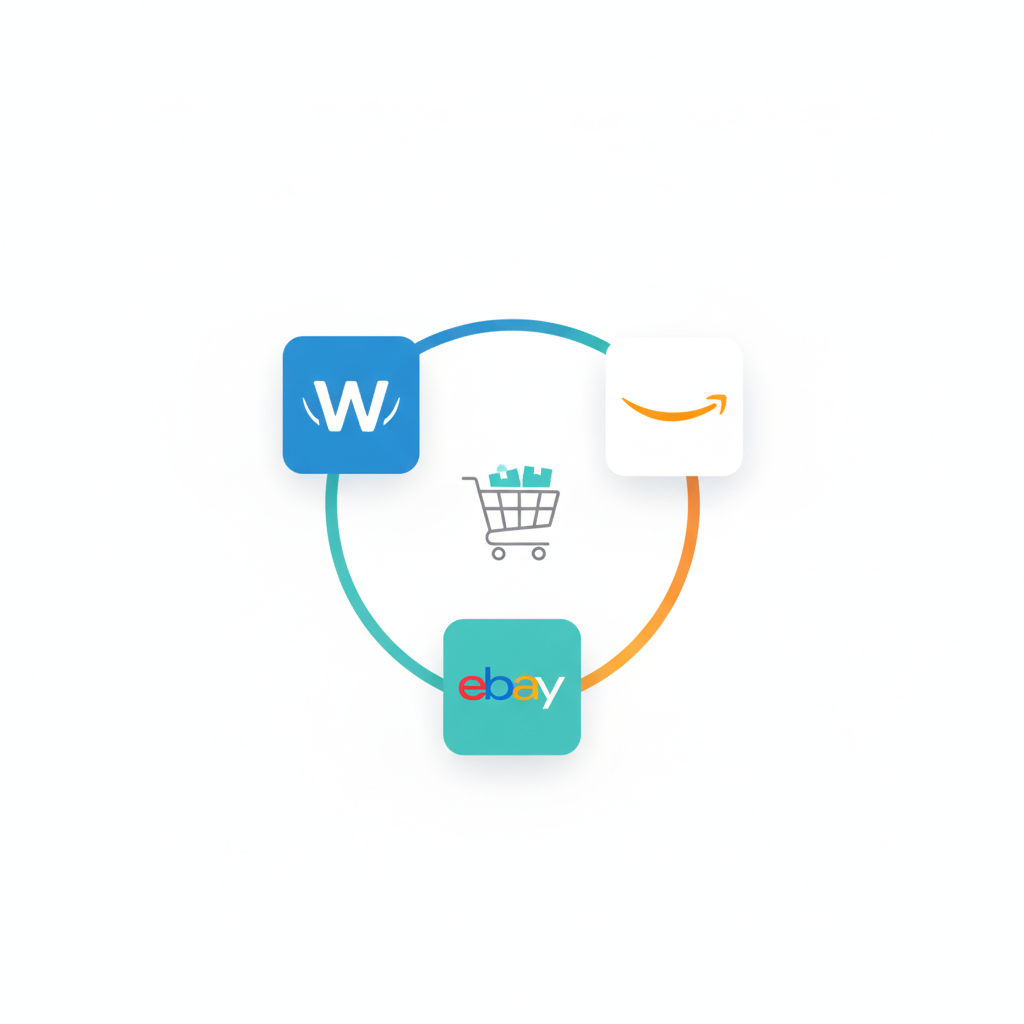Bottom line: If you’re still selling on just one platform in 2025, you’re leaving money on the table. Multichannel selling isn’t just a growth strategy anymore—it’s table stakes for staying competitive.
The numbers tell a clear story. E-commerce now accounts for 16.3% of all U.S. retail sales, hitting $304 billion in Q2 2025 alone. But here’s what matters more: your customers aren’t loyal to a single platform. They browse Amazon for quick purchases, hunt for deals on eBay, and visit brand websites when they want something special.
The question isn’t whether multichannel selling matters—it’s whether you can afford to ignore it.

Why 2025 Is the Year for Multichannel (Whether You’re Ready or Not)
Let’s cut through the noise with some facts that should grab your attention:
The multichannel e-commerce software market jumped from $9.5 billion in 2024 to a projected $25.2 billion by 2033. That’s not just growth—that’s explosive adoption driven by real results, not hype.
Amazon Marketplace alone is expected to see $2.5 trillion in growth this year. Here’s the kicker: global competition has actually dropped by 30%. Translation? There’s a window of opportunity right now for sellers willing to act.
Meanwhile, global e-commerce sales are racing toward $10 trillion by 2027, and the customer journey is more fragmented than ever. Your potential buyers are researching on Google, comparing prices on Amazon, checking reviews on your website, and possibly buying on eBay. If you’re not there, someone else is.
The Problem with Going Solo (And Why Your Competitors Aren’t)
Here’s the uncomfortable truth: selling on a single platform is risky business. One policy change, one algorithm update, or one account suspension can devastate your revenue overnight. It’s not fear-mongering—it’s just reality for sellers who put all their eggs in one basket.
But there’s another issue. Consumer behavior has changed. About 73% of customers use multiple channels to research products before buying. If they can’t find you where they’re looking, they’ll find your competitor instead.
The data backs this up dramatically. Brands selling on three or more marketplaces see 104% growth in gross merchandise value compared to single-channel sellers. That’s not a typo—we’re talking about doubling your growth potential simply by diversifying where you sell.
Why Manual Management Will Break You (Long Before It Breaks Your Business)
Now for the reality check: expanding to multiple channels means managing multiple inventories, multiple orders, and multiple headaches—if you try to do it manually.
Imagine this scenario: You make a sale on Amazon. While you’re updating your inventory there, someone buys the same product on eBay. Before you update eBay, your WooCommerce store processes another order. Now you’re oversold, facing angry customers and potential account penalties.
This isn’t a hypothetical nightmare—it’s Tuesday afternoon for sellers without proper automation.
The good news? We’ve entered an era where 92% of businesses are using AI and automation for e-commerce operations. The technology isn’t just accessible; it’s become essential for scaling without losing your sanity.
This is where integration tools like WP-Lister become critical. You can automate product listings from WooCommerce to both eBay and Amazon, with real-time inventory synchronization across all channels. It’s not about working harder—it’s about working smarter.

Your Three-Platform Ecosystem: WooCommerce, Amazon, and eBay
Think of your multichannel strategy as an ecosystem where each platform plays a specific role. Understanding these roles helps you optimize your presence on each.
Your WooCommerce Store: Where You Build Your Brand
This is your home base—the one place where you control everything. No marketplace fees eating into your margins. No restrictive policies limiting how you communicate with customers. Complete ownership of customer data and relationships.
WooCommerce powers millions of online stores globally, and there’s a reason: flexibility. This is where your highest margins live and where you nurture customer relationships that lead to repeat purchases. Your WooCommerce store isn’t just a sales channel—it’s your brand’s flagship.
Amazon: Your Volume Engine
Amazon customers arrive with buying intent. They’re not browsing for entertainment—they’re ready to purchase. With decreased competition and massive marketplace growth, Amazon is ideal for driving significant sales volume.
The strategy? Use Amazon for product discovery and volume sales, then guide customers back to your WooCommerce store for the relationship phase. WP-Lister makes this seamless by keeping your Amazon listings synchronized with your WooCommerce inventory. You never oversell, and you maximize visibility where millions of shoppers are actively searching.
eBay: The Deal-Hunter’s Paradise
eBay serves a different crowd—bargain hunters, collectors, and shoppers searching for specific items. It’s particularly effective for clearing overstock, reaching price-sensitive customers, and selling in categories where eBay has historically strong buyer bases.
The auction format also provides a unique testing ground. Want to gauge demand for a new product? Try it on eBay first. With WP-Lister’s eBay integration, you can manage both fixed-price listings and auctions directly from WooCommerce, maintaining centralized control over your entire catalog.
Five Non-Negotiables for Multichannel Success
After watching countless sellers succeed (and struggle) with multichannel strategies, five critical factors separate the winners from the also-rans:
1. Centralized Inventory—Your Single Source of Truth
Your inventory must live in one place—your WooCommerce store—and flow outward to all channels. This “single source of truth” prevents the nightmare scenario of selling the same item simultaneously on multiple platforms.
Multi-channel fulfillment strategies can cut out-of-stocks by 19% when inventory is properly pooled and synchronized. That’s fewer angry customers, fewer refunds, and better seller metrics across all platforms.
WP-Lister handles this automatically. When inventory changes in WooCommerce—whether from a sale, new stock arrival, or manual adjustment—all channels update immediately. No spreadsheets, no manual entry, no overselling.
2. Strategic Pricing—Because One Size Doesn’t Fit All
Different platforms warrant different pricing strategies, and with e-commerce projected to account for 24% of global retail sales, pricing optimization is crucial.
Your WooCommerce store can typically support higher prices because customers value the direct brand relationship. Amazon prices might be slightly lower to account for marketplace fees while staying competitive. eBay pricing can be the most aggressive to capture deal-seekers.
The trick? Ensure profitability across all channels while accounting for platform fees, shipping costs, and desired margins. WP-Lister lets you set platform-specific pricing rules, optimizing for each channel without manually adjusting every product.
3. Automated Order Management—Scale Without the Chaos
When orders arrive from Amazon or eBay, they need to flow back into WooCommerce where you process fulfillment. Manual order entry doesn’t scale—it barely survives at low volumes.
WP-Lister automatically imports orders from Amazon and eBay into WooCommerce, appearing alongside your direct website orders. You pick, pack, and ship from one system regardless of where the sale originated.
What’s manageable at 10 orders daily becomes impossible at 100. Automation is what makes that growth possible without hiring a small army.
4. Platform-Specific Optimization—Same Brand, Different Packaging
Your product information should be consistent, but presentation needs optimization for each platform’s unique algorithm and customer base.
Amazon’s search works differently than eBay’s, which works differently than your WooCommerce store’s. Product titles, descriptions, and images should be tailored for each platform’s best practices while maintaining consistent branding.
WP-Lister enables this through customizable listing templates. Maintain your core product information in WooCommerce while automatically formatting it for Amazon and eBay’s specific requirements and character limits.
5. Data-Driven Decisions—Because Guessing Is Expensive
Up to 99% of retailers have explored or implemented composable commerce approaches, emphasizing data-driven decisions about which products to sell where.
Not every product performs equally on every platform. Some items fly off shelves on Amazon while collecting dust on eBay, or vice versa. Track performance by channel to optimize your catalog for each platform.
Review sales data regularly. Identify which products work best where, then adjust accordingly. This might mean featuring certain products more prominently on specific platforms or making some items channel-exclusive where they perform best.

Four Mistakes That Will Cost You (And How to Avoid Them)
The Overselling Disaster
Selling the same item across multiple platforms without proper synchronization inevitably leads to overselling. This damages seller metrics, frustrates customers, and can result in account suspensions.
The fix is real-time inventory synchronization. When you make a sale on any channel, inventory must update immediately everywhere. This is core to WP-Lister—ensuring available quantity accuracy regardless of where sales occur.
The Manual Management Death Spiral
Many sellers start by manually copying and pasting product information between platforms. This works for 10 products but becomes unsustainable at 100 or 1,000.
Establish automated workflows from day one, even with a small catalog. This means you’re ready to grow without hitting operational bottlenecks.
The Race to the Bottom
Competing purely on price erodes margins and isn’t sustainable long-term. Instead, compete on value: faster shipping, better product information, superior customer service, unique product selection.
Use pricing strategically, but don’t make it your only competitive advantage.
The Policy Compliance Nightmare
Amazon’s policies change constantly, and eBay has its own evolving requirements. Stay informed about changes on each platform, and ensure your integration tools maintain compliance automatically.
WP-Lister stays updated with platform requirements, adjusting listing formats and required fields as platforms evolve.
Your 30-Day Launch Plan
Ready to expand beyond your WooCommerce store? Here’s a practical roadmap:
Week 1: Foundation
- Audit your WooCommerce product catalog for completeness and accuracy
- Set up Amazon and eBay seller accounts if needed
- Install and configure WP-Lister
- Establish pricing strategy for each platform
Week 2: Initial Launch
- Select 10-20 best-performing products to list first
- Create platform-optimized titles and descriptions using templates
- Configure inventory synchronization rules
- Launch initial listings
Week 3: Optimization
- Monitor listing performance and adjust
- Test different titles, prices, and images
- Expand to additional products based on results
- Refine fulfillment workflow
Week 4: Analysis and Scaling
- Review sales data across channels
- Identify which products perform best where
- Adjust catalog strategy
- Plan next expansion phase
The Technology That Actually Matters
None of this works without proper integration technology. Manual management doesn’t scale, and attempting it limits growth while consuming all your time.
WP-Lister solves this specifically for WooCommerce sellers:
- Real-time inventory synchronization preventing overselling
- Automated order import from Amazon and eBay
- Bulk listing management for hundreds or thousands of products
- Platform-specific templates optimizing listings for each marketplace
- Flexible pricing rules maintaining profitability across channels
Rather than piecing together multiple tools or attempting manual management, WP-Lister provides an integrated solution growing with your business.
Looking Ahead: The Future Is Already Here
AI agents are expected to account for 20% or more of e-commerce traffic within five years, fundamentally changing how customers discover and purchase products.
This evolution makes multichannel presence even more critical. As AI shopping assistants compare prices and features across platforms, you want your products visible wherever these intelligent agents look.
Unified commerce—integrating all sales channels into one platform—is emerging as the next evolution of multichannel selling. This is exactly what WP-Lister enables: treating your WooCommerce store as the central hub while seamlessly extending to Amazon and eBay.
Your Next Move
The market data is clear: multichannel selling isn’t optional in 2025—it’s how successful e-commerce businesses operate. The market is growing, competition in some channels is actually decreasing, and the technology to manage it has never been more accessible.
The question isn’t whether you should expand to multiple channels. It’s how quickly you can implement it effectively.
Start by assessing your WooCommerce store and identifying top-performing products. These are your multichannel pioneers—the products you’ll list first on Amazon and eBay.
Then implement automation infrastructure making multichannel management sustainable. Explore WP-Lister for eBay and WP-Lister for Amazon to see how they streamline your operations.
The sellers who thrive in 2025 and beyond meet customers wherever they prefer to shop—and have the systems in place to do so profitably and sustainably.
Ready to scale your WooCommerce store across multiple channels? Explore WP-Lab’s solutions and discover how straightforward multichannel selling can be with the right platform.

References and Further Reading
Industry Statistics and Data Sources:
- U.S. E-commerce Retail Sales Q2 2025 – LinkedIn Industry Analysis
- Multi-Channel E-commerce Software Market Outlook – Market valuation and growth projections
- Amazon Marketplace 2025 Statistics – Marketplace growth and competition analysis
- Top E-commerce Statistics 2025 – Global e-commerce projections
- E-commerce Trends and AI Adoption – Business automation statistics
- Multi-Channel Fulfillment Strategies – Inventory optimization data
- E-commerce Pricing Strategies – Retail sales projections
- Composable Commerce Adoption – Retailer implementation trends
- Amazon FBA and Policy Changes – Compliance and regulations
- Agentic Commerce and AI Trends – Future of e-commerce traffic
- Unified Commerce Evolution – Multi-channel integration trends
WooCommerce Resources:
- WooCommerce as the #1 E-commerce Platform – Platform market share and adoption
- WooCommerce Multi-Channel Selling Guide – Official WooCommerce documentation
- Multi-Channel Strategy Best Practices – Strategic implementation guide
Related Tools and Solutions:
- WP-Lister for eBay – eBay integration for WooCommerce
- WP-Lister for Amazon – Amazon integration for WooCommerce
